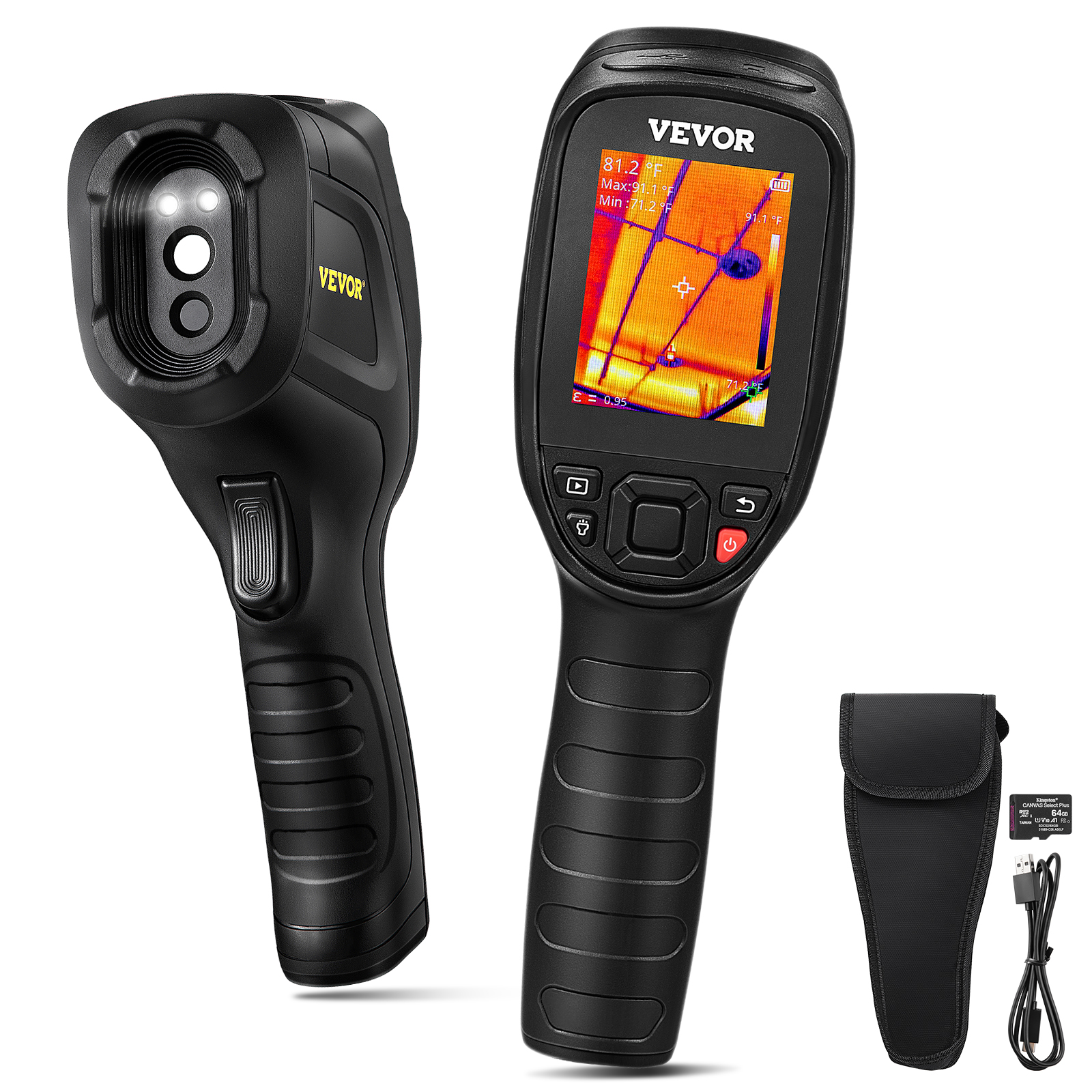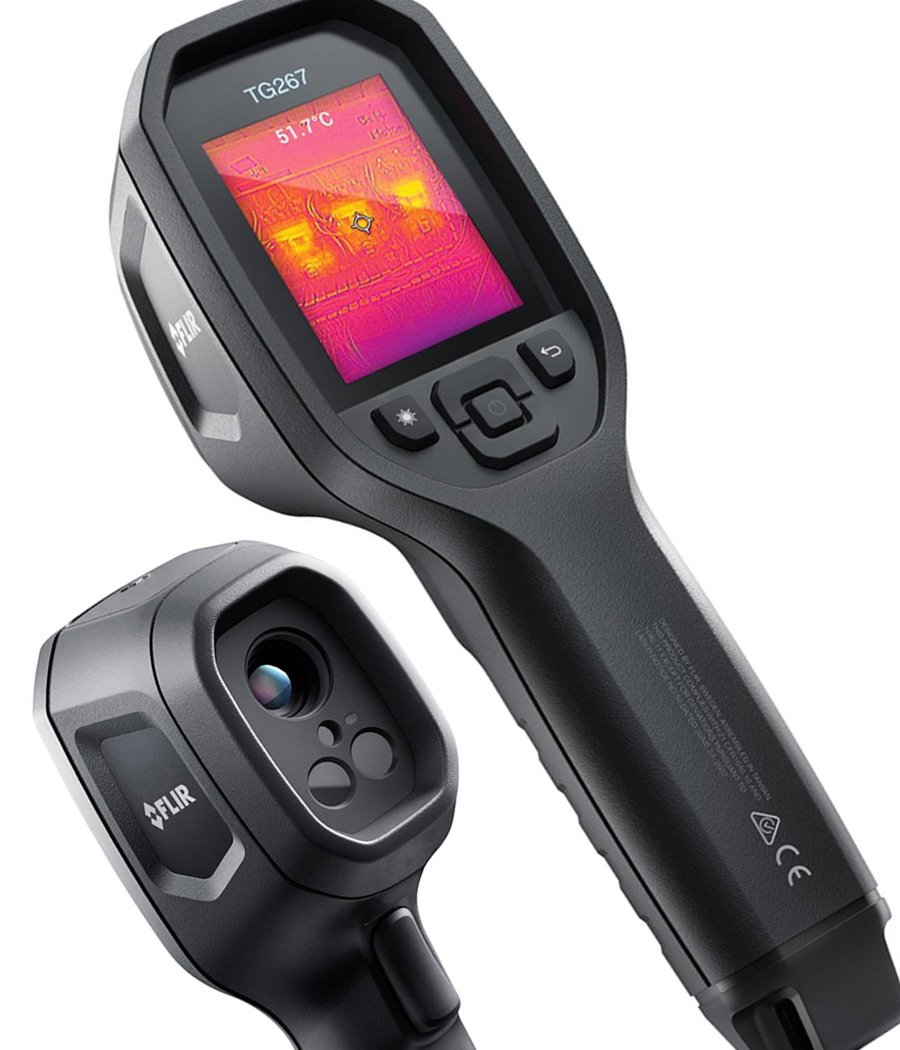PROS: High thermal resolution, Smooth framerate, wide temperature range, very long battery life, IP54 waterproof.
CONS: Given the low price, one cannot complain of anything of substance.
| Product | Type | Resolution | Battery capacity | Waterproof | LCD screen | Price |
|---|---|---|---|---|---|---|
VEVOR SC240 M/N  | Handheld | 240 x 180 | 11 Hours (SC240M), 9 Hours (SC240N) | Yes | 2.8″ | Click for more info |
Flir TG165-X  | Handheld | 80 x 60 | 5 hours | Yes | 2.4″ | Click for more info |
FLIR TG267  | Handheld | 160 x 120 | 5 hours | Yes | 2.4″ | Click for more info |
VEVOR SC240 M/N Specifications
| Type | Handheld |
|---|---|
| Resolution | 240 x 180 |
| Pixels | 43,200 |
| Connectivity | USB-C |
| Temperature range | -4 F to 1022 F (-20 C to 550 C) for the SC240M and -4 F to 662 F (-20 C to 350 C) for the SC240N |
| Accuracy | +/- 2 C |
| Thermal sensitivity | 0.04 (NETD <40mk) |
| Distance | 1.6-13.1 ft/0.5-4 m |
| Storage Type | 64 Gb (SC240M), 16 Gb (SC240N) |
| Battery capacity | 11 Hours (SC240M), 9 Hours (SC240N) |
| Dimensions | |
| LCD screen | 2.8″ |
| Refresh rate | 20 Hz |
| Applications | HVAC inspection, Electrical inspections, Plumbing, Roofing, Automotive Diagnostics |
| View Angle | 52.5 x 39.5 |
VEVOR SC240 M/N – Specs & Review
Now in this article, I’m going to cover what is actually two different thermal cameras. There’s the Vevor SC240M and the Vevor SC240N. You see, they look almost identical but there are some key differences, mainly the fact that the Vevor SC240M is equipped with a 2MP visual camera while the SC240N is not.
Both of these are equipped with the same type of connectivity and in this case it is just the USB-C port. Of course, there’s a price difference between the two and if you want the TL;DR, just buy the SC240M and pay the extra 80$, you’ll thank me for it.
So as I mentioned, on the back of the camera you’ll find the thermal sensor, 2 LED lights a visual camera or not, depending on which version you chose. On the front, you’ll find a 2.8″ LCD display screen, 9 buttons to operate the camera and a trigger button. The USB port and built-in SD card slot are on the bottom of this handheld thermal camera.
VEVOR SC240 M/N – Thermal imaging quality
Now regardless of which version you choose, the infrared sensor will be more or less the same because both versions have an IR resolution of 240 x 180, totalling 43,200 pixels. This is about 25% more than what you would get from the average thermal camera in this price range, so extra points for the Vevor here. Sure, things are moving quite fast and in the last 6 months we’ve seen a big amp in the number of pixels that you can get especially with infrared thermal imager cameras under 500$.
Then there’s the framerate which is 20Hz. Now even though lately we’ve had more and more 25Hz thermal cameras prop up, especially from chinese manufacturers, the norm is still 9 Hz for most cameras so both Vevor SC240 M/N cameras get extra points here. The picture is considerably smoother and just makes for a better experience. The difference between 9Hz and 20Hz is actually much more noticeable than between 20Hz and 30Hz, the bigger the number the less you perceive it.
In terms of viewing modes, on the SC240N you just get thermal mode but on the SC240M you also get 3 additional ones: Visible Light (The image coming from the 2 megapixel visual camera), Thermal Fusion (A blend between visual and thermal, most popular mode) and Picture-In-Picture.
You can capture thermal images but these particular thermal imaging cameras can also record video.
VEVOR SC240 M/N – Temperature Range, Accuracy
But now let’s look at how well these infrared cameras can do temperature measurement. First of all, let’s look at the temperature range because here is one place where these cameras differ. The Vevor SC240M can measure any temperature between -4 F to 1022 F (-20 C to 550 C) while the Vevor SC240N can only measure temperatures between -4 F to 662 F (-20 C to 350 C). So certainly, there’s a difference. If you ask me and this is just a subjective opinion, the limitation might be just from the firmware.
Now we come to the most sensitive topic and that is thermal sensitivity because the manufacturer claims a 40 mK NETD thermal sensitivity. Now that would put it at the same level as a Flir E6-XT and the reality is that the images look much more detailed on the E6-XT. You see, the more sensitivity the sensor has, the more detailed the image. While the images on the Vevore SC240 look great, whether they look as detailed as on a camera with a true 40 mK sensitivity is arguable. But this is just my subjective point of view.
Then there is the matter of accuracy and both cameras can measure temperatures with a +/- 2 C accuracy. The viewing angle is 52.5 x 39.5 so it is more or less as wide as the one from other cameras.
VEVOR SC240 M/N – Battery life & Memory
Now we get to the storage part and here both cameras deliver because while the SC240N comes with 16Gb of storage, the SC240M comes with 64GB. While you can mount a 64GB SD Card on other thermal cameras, you have to hand it to Vevor for raising the standard on the amount of gigabytes offered as standard.
There’s also a key difference in battery life because the SC240N’s li-ion battery should last for about 9 hours but the SC240M should last a whooping 11 hours.
Both versions come with an IP54 waterproof housing so you needn’t worry if it rains on the device or if light water splashes get to it. Just don’t drop it in water.
All things considered, I do personally believe that the SC240M is worth it because of the visual camera, wider temperature range, more storage space and especially longer battery life.
